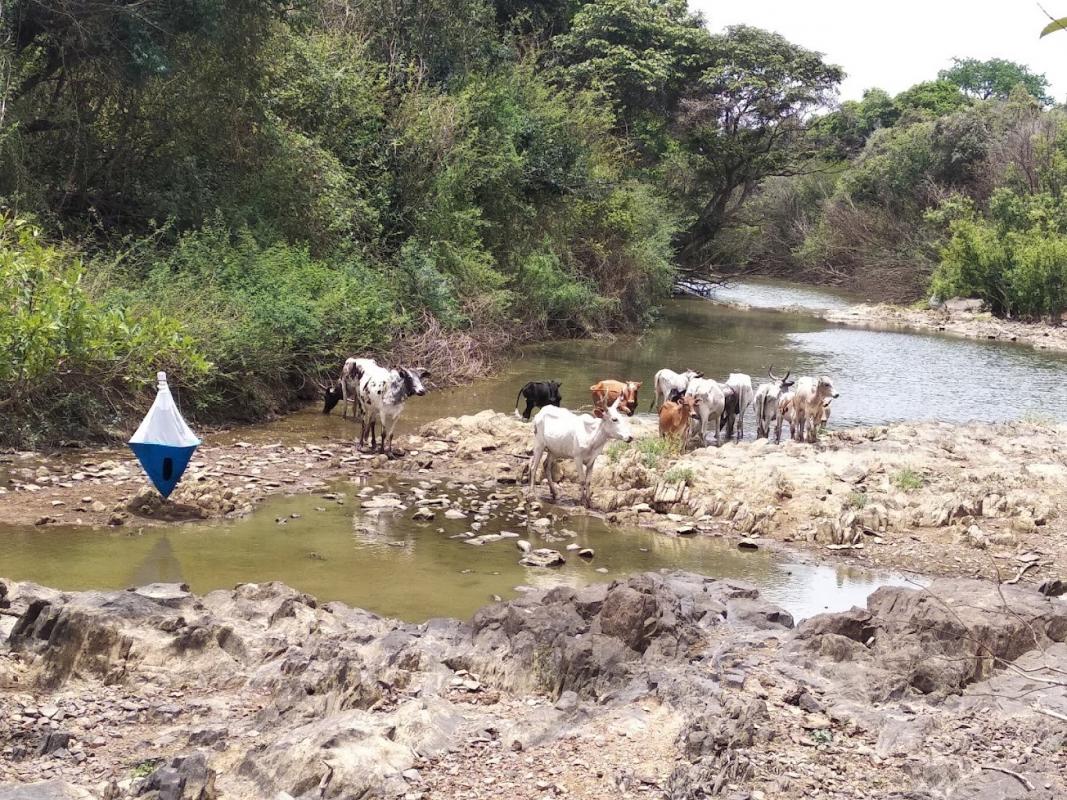- Home
- Worldwide
- CIRAD worldwide
- Projects
- COMBAT project
Controlling and progressively minimising the burden of animal trypanosomosis - COMBAT

Vavoua biconical trap, Gaoua, Burkina Faso © Alain Boulangé, CIRAD
Issues
Vector-borne diseases affecting livestock have serious impacts in Africa. Trypanosomosis is caused by parasites transmitted by tsetse flies and other blood-sucking Diptera. The animal form of the disease is a huge problem for African livestock farmers. There is no vaccine, and existing drugs are becoming less effective because of the development of resistance in parasites. Existing diagnosis methods are difficult to use in the field, while vector control tools are often environmentally unsound and need to be improved. A human form of the disease also exists, known as human African trypanosomosis or sleeping sickness. Over the last 20 years, limited progress has been made in controlling animal trypanosomosis. This situation stands in sharp contrast to progress made in the control of sleeping sickness, which the World Health Organization (WHO) is currently in the process of eliminating.
Description
For a four-year period, the COMBAT project, built around a consortium of 21 participants coordinated by CIRAD, with representatives in 13 African countries, will implement activities around four thematic pillars:
- It will improve the knowledge base on interactions between host vectors and parasites in AT (pillar 1); in particular, studies will be conducted on the capacity of vectors to transmit the disease, on their spread and their role in the dissemination of the disease, on disease tolerance in livestock species in Africa, and on drug resistance of trypanosomes.
- It will develop innovative control tools (pillar 2); around 10 tools will be examined. These will range from new environmentally-friendly insect control devices to innovative diagnostic methods and tests of new trypanocidal molecules;
- It will consolidate surveillance, diagnosis and control networks, by setting up epidemiological information systems and harmonised national and regional control strategies (pillar 3). The project will also strengthen surveillance of the disease and its vectors, predict the risk of spread and develop information systems to enable risk-based decision making; it will also assess the cost of AT different geographical scales;
- Finally, COMBAT will build the capacities of all stakeholders, from researchers to African livestock farmers and veterinary services, to fight the disease, while raising awareness among policymakers (pillar 4).
COMBAT will engage a large number of countries affected by AT through regional initiatives.
Expected impacts
- Actors’ knowledge of the epidemiological cycles of AT (vectors, parasites and their hosts, domestic and wild animals) will be improved, by studying their interactions in the laboratory and in the field;
- Control of AT will be strengthened, based on improved prevention, surveillance, detection and treatment tools;
- Information systems on TA and its vectors will be developed at the continental and national levels;
- The impact of TA will be assessed at different geographical scales (continental, national, local);
- Strategies to tackle AT will be improved by developing and fully disseminating the progressive control pathway approach and integrating it into national policies;
- The capacities and awareness of COMBAT’s partners and of actors involved in AT control will be increased.
Through a sustainable reduction in the incidence and the burden of animal trypanosomosis, COMBAT will contribute to achieving a certain number of sustainable development goals, especially reducing poverty and ending hunger.
Contract partners
- Institut de recherche pour le développement (IRD), France ;
- Institut d'électronique et des systèmes (Université de Montpellier) (IES), France ;
- Vrije Universiteit Brussel (VUB) Belgique ; Universidad de Las Palmas de Gran Canaria (ULPGC), Espagne ;
- International Centre of Insect Physiology and Ecology (ICIPE), Kenya ;
- Centre international de recherche développement sur l’élevage en zone subhumide (Cirdes), Burkina Faso ;
- Universidade Eduardo Mondlane (UEM), Mozambique ;
- Makerere University (MAK), Ouganda ;
- Institut sénégalais de recherches agricoles (Isra), Sénégal ;
- Institut Pierre Richet (Institut national de santé publique, IPR), Côte d’Ivoire ;
- Institut de recherche en élevage pour le développement (Ired), Tchad ;
- Central Veterinary Research Laboratory (Animal Resources Research Corporation, CVRL), Soudan ;
- Agricultural Research Council (ARC), Afrique du Sud ;
- Insectarium de Bobo-Dioulasso (ministère des Ressources animales et halieutiques), IBD, Burkina Faso ;
- Mission spéciale d’éradication des glossines (ministère de l'Élevage, des Pêches et des Industries animales), MSEG, Cameroun ;
- National Institute for Control and Eradication of Tsetse fly and Trypanosomosis (NICETT), Éthiopie ;
- Kenya Tsetse and Trypanosomiasis Eradication Council (KENTTEC), Kenya ;
- Tsetse and Trypanosomiasis Control Unit (Ministry of Fisheries and Livestock), TTCU, Zambie ;
- Division of Tsetse Control services (Ministry of lands, agriculture, water and rural resettlement), TCD, Zimbabwe ;
- United Nations Food and Agriculture Organization (FAO), Italie
























